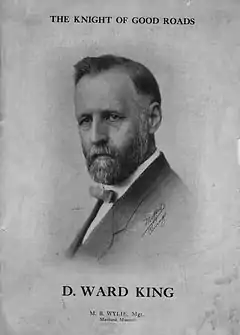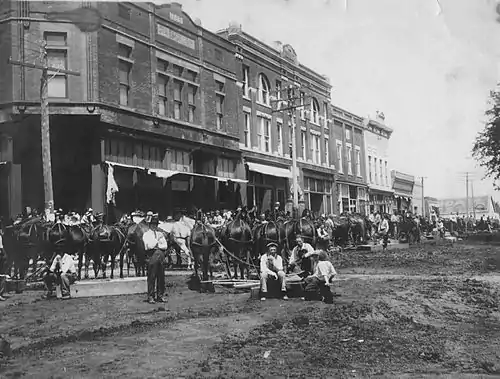Maitland, Missouri
Maitland is a city in Holt County, Missouri, United States. The population was 343 at the 2010 census. At one point the city billed itself as the "Bluegrass Mecca"—home to the largest bluegrass farm in the world.[6]
Maitland, Missouri | |
|---|---|
 Location of Maitland, Missouri | |
| Coordinates: 40°12′5″N 95°4′32″W | |
| Country | United States |
| State | Missouri |
| County | Holt |
| Area | |
| • Total | 0.31 sq mi (0.81 km2) |
| • Land | 0.31 sq mi (0.81 km2) |
| • Water | 0.00 sq mi (0.00 km2) |
| Elevation | 945 ft (288 m) |
| Population | |
| • Total | 343 |
| • Estimate (2019)[3] | 308 |
| • Density | 987.18/sq mi (380.62/km2) |
| Time zone | UTC-6 (Central (CST)) |
| • Summer (DST) | UTC-5 (CDT) |
| ZIP code | 64466 |
| Area code(s) | 660 |
| FIPS code | 29-45596[4] |
| GNIS feature ID | 0730138[5] |
History
Maitland was platted in 1880.[7] The town is named after John Skirving Maitland, who was a surveyor for the Nodaway Valley Railroad (the construction company for the Kansas City, St. Joseph and Council Bluffs Railroad) that arrived in Maitland in 1880 when its superintendent, John Fisk Barnard, purchased the land for the town from John S. and Delila Swope. The railroad would eventually be taken over by the Burlington Northern Railroad before eventually being abandoned.[8]



Maitland is a farming community. One of the farmers from Maitland was David Ward King, inventor and promoter of the King road drag—an invention that essentially was two logs lashed together and dragged behind horse or mule teams that was an effective and inexpensive method to grade dirt roads. It was the horse-drawn forerunner of the modern road grader. The invention came at the time Henry Ford started to mass-produce automobiles. Before its invention, wet country roads became muck and were often nearly impassable. The use of the King Road Drag kept rural roads solid, even when wet, which rendered them passable all the time. These improved rural roads made possible both the advent of the automobile and rural mail delivery.[9]
In the first half of the 20th century, Maitland claimed to have the largest bluegrass seed producing farm in the world. John Q. Weller was to claim that the 10,000,000 pounds (4,500,000 kg) of seed produced on his farm was more than the harvested seed output of the entire state of Kentucky.[10] In some years, Weller would get permission to pile up bumper crops of seed on the city streets. During the harvest time in late June/early July, the town hosted a Bluegrass festival.
Bluegrass seed production in the late 1950s/early 1960s moved to farming communities in Idaho, Oregon and Washington. The Festival has been discontinued.
In 1975 the Maitland Community Betterment Association celebrated the bluegrass stripping heritage with the slogan, "Home of the Strippers."[11]
Geography
Maitland is located at 40°12′5″N 95°4′32″W (40.201256, -95.075533).[12]
According to the United States Census Bureau, the city has a total area of 0.30 square miles (0.78 km2), all land.[13]
Demographics
| Historical population | |||
|---|---|---|---|
| Census | Pop. | %± | |
| 1890 | 484 | — | |
| 1900 | 805 | 66.3% | |
| 1910 | 736 | −8.6% | |
| 1920 | 716 | −2.7% | |
| 1930 | 576 | −19.6% | |
| 1940 | 539 | −6.4% | |
| 1950 | 456 | −15.4% | |
| 1960 | 427 | −6.4% | |
| 1970 | 319 | −25.3% | |
| 1980 | 415 | 30.1% | |
| 1990 | 338 | −18.6% | |
| 2000 | 342 | 1.2% | |
| 2010 | 343 | 0.3% | |
| 2019 (est.) | 308 | [3] | −10.2% |
| U.S. Decennial Census[14] | |||
2010 census
As of the census[2] of 2010, there were 343 people, 144 households, and 100 families residing in the city. The population density was 1,143.3 inhabitants per square mile (441.4/km2). There were 161 housing units at an average density of 536.7 per square mile (207.2/km2). The racial makeup of the city was 99.1% White, 0.3% Native American, and 0.6% from other races. Hispanic or Latino of any race were 0.6% of the population.
There were 144 households, of which 31.9% had children under the age of 18 living with them, 53.5% were married couples living together, 11.8% had a female householder with no husband present, 4.2% had a male householder with no wife present, and 30.6% were non-families. 27.1% of all households were made up of individuals, and 12.5% had someone living alone who was 65 years of age or older. The average household size was 2.38 and the average family size was 2.81.
The median age in the city was 37.4 years. 24.5% of residents were under the age of 18; 9.6% were between the ages of 18 and 24; 25.3% were from 25 to 44; 26.2% were from 45 to 64; and 14.3% were 65 years of age or older. The gender makeup of the city was 49.3% male and 50.7% female.
2000 census
As of the census[4] of 2000, there were 342 people, 143 households, and 90 families residing in the city. The population density was 1,179.7 people per square mile (455.3/km2). There were 173 housing units at an average density of 596.7 per square mile (230.3/km2). The racial makeup of the city was 100.00% White. Hispanic or Latino of any race were 0.29% of the population.
There were 143 households, out of which 32.2% had children under the age of 18 living with them, 48.3% were married couples living together, 8.4% had a female householder with no husband present, and 36.4% were non-families. 32.9% of all households were made up of individuals, and 18.2% had someone living alone who was 65 years of age or older. The average household size was 2.39 and the average family size was 3.08.
In the city the population was spread out, with 27.8% under the age of 18, 7.9% from 18 to 24, 24.3% from 25 to 44, 24.3% from 45 to 64, and 15.8% who were 65 years of age or older. The median age was 38 years. For every 100 females, there were 112.4 males. For every 100 females age 18 and over, there were 102.5 males.
The median income for a household in the city was $31,250, and the median income for a family was $39,500. Males had a median income of $30,250 versus $18,750 for females. The per capita income for the city was $13,743. About 6.0% of families and 10.9% of the population were below the poverty line, including 13.3% of those under age 18 and 8.3% of those age 65 or over.
Education
Nodaway-Holt R-VII School District is the local school district for the area, with an elementary school in Maitland and a junior-senior high and district headquarters in Graham.[15]
References
- "2019 U.S. Gazetteer Files". United States Census Bureau. Retrieved July 26, 2020.
- "U.S. Census website". United States Census Bureau. Retrieved 2012-07-08.
- "Population and Housing Unit Estimates". United States Census Bureau. May 24, 2020. Retrieved May 27, 2020.
- "U.S. Census website". United States Census Bureau. Retrieved 2008-01-31.
- "US Board on Geographic Names". United States Geological Survey. 2007-10-25. Retrieved 2008-01-31.
- Maitlandmo.com history
- Eaton, David Wolfe (1916). How Missouri Counties, Towns and Streams Were Named. The State Historical Society of Missouri. pp. 174.
- "Blue Grass Mecca", Biographical sketches from Maitland Centennial, 1980
- Malcolm Gladwell, The New Yorker, December 6, 1999, Don't believe the Internet hype: the real E-commerce revolution happened off-line. Historic Importance of King Road Drag Archived 2009-12-31 at the Wayback Machine
- Daily Capital News - Jefferson City, Missouri - July 10, 1937
- https://www.newspapers.com/clip/5394026/maitland_home_of_strippers_may_22_1975/
- "US Gazetteer files: 2010, 2000, and 1990". United States Census Bureau. 2011-02-12. Retrieved 2011-04-23.
- "US Gazetteer files 2010". United States Census Bureau. Archived from the original on 2012-01-25. Retrieved 2012-07-08.
- "Census of Population and Housing". Census.gov. Retrieved June 4, 2015.
- "Home". Nodaway-Holt R-VII School District. Retrieved 2021-01-23.
District Office 318 S. Taylor Street Graham, MO 64455660-939-2135 Elementary School 409 Hickory Street Maitland, MO 64466660-935-2514 High School 318 S. Taylor Street Graham, MO 64455660-939-2135
External links
- Historic maps of Maitland in the Sanborn Maps of Missouri Collection at the University of Missouri
